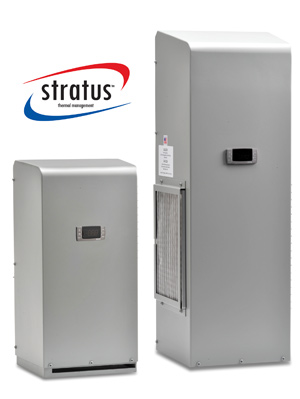Internal and External sources often cause enclosure internal temperatures to rise above the ratings of the control equipment. Internally, the same items that can be damaged by heat (power supplies, PLC systems, AC drives/inverters, HMI systems, battery back-up systems, servos, etc.) may also be the source of the heat. Externally, sources of heat that can
cause the internal temperature of your enclosure to rise above a desired level include items such as industrial ovens, blast furnaces, foundry equipment, solar heat gain, and more. But, how do you get the heat out of your enclosure and away from those critical components? Do you need a fan or do you need something like forced convection or closed-loop cooling? Here are factors to consider when selecting an enclosure fan or air conditioner.
Fan Selection
To select the proper size (CFM) fan for your forced air cooling solution, you need to determine the amount of heat to be removed (in watts) and determine the Delta T (Max. allowable internal enclosure temperature °F – Max. outside ambient temperature°F).
CFM = Cubic Feet per Minute
P = Power to be dissipated in watts
CFM = (3.17 x Pwatts) / Delta T °F
Delta T = max. allowable internal enclosure temperature °F – max.
outside ambient temperature °F

Fan Selection Example
A NEMA 12 Hubbell Wiegmann N12302412 enclosure (30″ high x 24″ wide x 12″ deep) contains a GS3-2020 AC drive (20 HP 230 volt) that has a maximum allowable operating temperature of 104°F and is located in a warehouse that has a maximum outside ambient air temperature of 95°F.
Power to be dissipated is stated in the specifications of the GS3-2020 and is found to be 750 watts, so P=750 watts
Delta T = Max. operating temperature for the GS3-2020 is 104°F – Max. ambient air temperature of 95°F
Delta T = 9°F
CFM = (3.17 x 750 watts) / 9°F
CFM = 264
Choose a Hubbell Wiegmann WPF60-115BK filter fan kit that provides 295 CFM with exhaust kit WPFA50-60BK
All part numbers used in examples are available at www.AutomationDirect.com/enclosure-cooling
Air Conditioner Selection
To select the proper size air conditioner, the worst-case conditions should be considered, but take care not to choose an oversized unit.
There are two main factors in choosing an uninsulated metal NEMA rated enclosure located indoors:
Internal Heat Load
Internal heat load is the heat generated by the components inside the enclosure. This can be determined by a few different methods. The preferred method is to add the maximum heat output specifications that the manufacturers list for all the equipment installed in the cabinet. This is typically given in Watts, so use the following conversion:
BTU per Hour = Watts x 3.413
Example: The Watt-loss chart for the AutomationDirect GS3 Drives shows that a GS3-2020 AC drive has a Watt-loss of 750 watts.
BTU per Hour = 750 watts x 3.413
BTU per Hour = 2559
Heat Load Transfer
Heat load transfer is the heat lost (negative heat load transfer) or gained (positive heat load transfer) through the enclosure walls with the surrounding ambient air. This can be calculated by the following formula:
Heat load transfer (BTU/H) = 1.25 x surface area (sq. ft. ) x (max. outside ambient air (°F) – max. allowable internal enclosure temperature
air (°F)) Surface Area (sq. ft.) = 2 [(H x W) + (H x D) + (W x D)] / 144 sq. inches
Note: 1.25 is an industry standard constant for metal enclosures;
0.62 should be used for plastic enclosures.
Once you have determined your Internal Heat Load and the Heat Load Transfer, you can choose the proper size unit by calculating the needed cooling capacity.
Cooling capacity (BTU/H) = Internal Heat Load ± Heat Load Transfer
Air Conditioner Selection Example
A NEMA 12 Hubbell Wiegmann N12302412 enclosure (30″ high x 24″ wide x 12″ deep) contains a GS3-4030 AC drive 30 HP 460 volt) that has a maximum allowable operating temperature of 104°F and is located in a warehouse that has a maximum outside ambient air temperature of 115°F. Power to be dissipated is stated in the specifications of the GS3-4030 and is found to be 1290 watts.
Internal heat load:
BTU per Hour = 1290 watts x 3.413
BTU per Hour = 4403 BTU/H
Heat load transfer:
Heat load transfer (BTU/H) = 1.25 x 19 sq. ft. x (115°F – 104°F)
Heat load transfer (BTU/H) = 261.25 BTU/H
Cooling capacity:
Cooling capacity (BTU/H) = 4403 BTU/H + 261.25 BTU/H
Cooling capacity (BTU/H) = 4664.25 BTU/H
In this example, you are able to determine that a 5000 BTU/H unit is needed. Select a TA10-050-16-12 Stratus air conditioner.
All part numbers used in examples are available at www.AutomationDirect.com/enclosure-cooling



